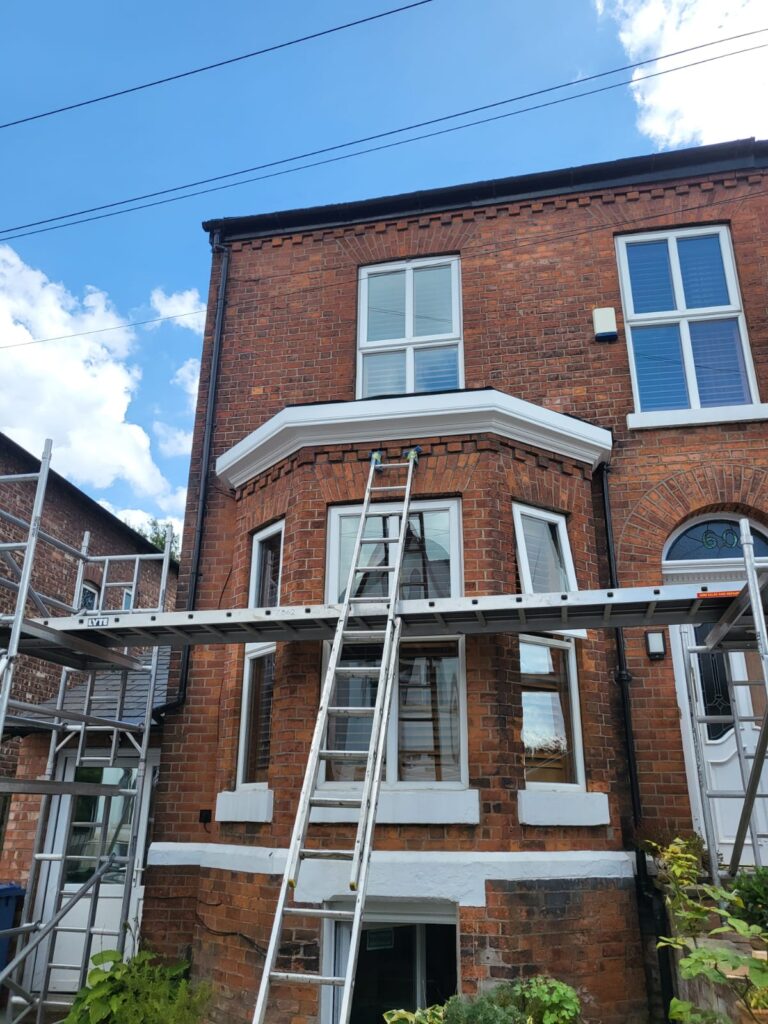For building contractors and property developers, understanding the long-term costs of painting timber windows and the various parts of the window is important for making informed specification decisions. While initial installation costs often drive window selection, the ongoing maintenance requirements and painting cycles can significantly impact the total lifetime functionality cost of different timber options.
Understanding Timber Window Maintenance Cycles

Traditional hardwood windows typically require repainting every 5-7 years to maintain their durable protective coating and aesthetic appeal, especially those constructed with timber frames. However, modern timber technologies like Accoya can extend these maintenance intervals to 12-15 years, dramatically reducing lifetime costs.
Traditional Hardwood Maintenance Requirements
- Full external repaint every 5-7 years
- Minor touch-ups every 2-3 years
- Regular inspection for damage or decay
- Potential repairs to degraded timber sections
Accoya Timber Maintenance Profile
- Complete repainting every 12-15 years
- Minimal touch-up requirements
- Enhanced resistance to decay and warping
- Reduced risk of paint failure
As you can see, Accoya is an excellent material that provides far more longevity than traditional hardwoods. Over time, this can significantly reduce overall maintenance costs across the lifespan of a window.
Breaking Down the Costs: Labour and Materials

Traditional Hardwood Painting Costs (Per Window)
- Professional labour: £85-£120
- Premium exterior paint: £25-£35
- Preparation materials: £15-£20
- Average total: £125-£175 per window
Accoya Maintenance Costs (Per Window)
- Professional labour: £85-£120 per window
- Premium exterior paint: £25-£35
- Preparation materials: £15-£20
- Average total: £125-£175 per window
While the individual painting costs are the same, the extended maintenance cycle of Accoya creates significant savings over time. Please remember that these figures are based on an average estimate and should not be used for accurate quotations. Factors such as paint cost and labour rates in different locations can affect overall costs.
30-Year Cost Comparison
Traditional Hardwood
- 6 painting cycles required
- Total cost per window: £750-£1,050
- Additional repair costs likely
Accoya
- 2-3 painting cycles required
- Total cost per window: £375-£525
- Minimal repair requirements
As you can see, over a 30-year comparison, Accoya windows work out significantly more cost-effective than traditional hardwoods windows. There are, however, other factors to consider with regards to wooden window maintenance.
Factors Affecting Maintenance Cycles
Local climate and exposure during the summer months
- Local climate and exposure
- Window orientation
- Paint quality and application
- Installation quality
- Regular cleaning practices
All these factors can impact the level of maintenance needed to keep wooden windows in the best possible condition.
Best Practices for Extending Paint Life

There are certain best practices to follow in this blog to maximise the lifespan of any timber window coatings and fittings. By following these procedures, any timber windows can be kept in excellent condition for many years to come.
- Use high-quality microporous paints
- Ensure proper surface preparation
- Apply recommended coating thickness
- Maintain adequate ventilation
- Address any issues promptly
Professional Installation Impact
Quality installation by experienced specialists can significantly extend maintenance intervals. As a building contractor working with GB Joinery and our qualified surveyor as your dedicated timber window specialist, we recommend that you always adhere to the following measures when installing timber windows and conservatories:
- Proper sealing and weather protection for timber window repair
- Correct glazing techniques
- Appropriate drainage and ventilation
- Expert finish application and stain application
We hope that this guide has been useful for gauging how to best maintain timber windows. While Accoya windows may have a higher initial cost, the reduced maintenance requirements and extended painting cycles can offer significant lifetime cost savings. For contractors and developers, these long-term considerations should factor into specification decisions alongside initial purchase price.
Remember to always consider both immediate and long-term costs when selecting timber windows and always factor in the local environment and specific project requirements. Professional installation and high-quality materials will always deliver the best return on investment through extended maintenance cycles and reduced repair needs.
Contact GB Joinery today for expert advice on timber window specifications and maintenance requirements for your next project. Call us on 0161 477 1818 or send us a message online and we’ll get back to you as quickly as possible.
Frequently Asked Questions
Can I repair minor damage on timber windows myself?
Yes, minor damage on timber windows can often be repaired by homeowners with some basic tools and materials. It’s important to assess the damage first, and for small scratches or dents, sanding and repainting may suffice, especially in autumn. Additionally, maintaining a regular maintenance schedule can help prevent more significant damage; for such issues, like rot, you may need to use wood filler or replace the affected sections.
What is the process for restoring old timber windows?
Restoring old timber windows typically involves several steps: first, remove any old paint and varnish using a paint stripper or sanding. Next, inspect the wood for damage and repair or replace any rotted sections, including hinges if necessary, to prevent draughts. After repairs, apply a suitable primer, followed by paint or wood finish to protect the wood. Finally, ensure that the window mechanisms, including hinges, are functioning properly for ease of use.
What products or materials are best for cleaning timber windows?
The best products for cleaning timber windows and their window frames include a gentle soap solution, such as dish soap mixed with water, to avoid damaging the wood and its paintwork. For tougher grime, a non-abrasive cleaner specifically designed for wood is ideal. Additionally, microfiber cloths can be used to avoid scratching the surface while cleaning.
How often should I clean and treat my timber window frames?
It is generally recommended to clean and treat your timber window frames at least once a year to maintain their appearance and protect them from the elements. However, if you live in a particularly harsh environment or notice signs of wear, you may need to do this more frequently.
When is it better to replace rather than repair timber windows?
It is often better to replace timber windows when the damage is extensive, such as significant rot or structural issues that compromise the window’s integrity. Additionally, if the windows are very old and not energy-efficient, replacement might be a more cost-effective long-term solution compared to continuous repairs.




